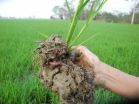(Press-News.org) Chemists at the University of Burgos (Spain) have manufactured a sheet that changes colour in the presence of water contaminated with mercury. The results can be seen with the naked eye but when photographing the membrane with a mobile phone the concentration of this extremely toxic metal can be quantified.
Mercury contamination is a problem that is particularly affecting developing countries. It poses a risk to public health since it accumulates in the brain and the kidneys causing long term neurological illnesses. It is emitted from industrial and mining waste, especially small-scale gold mining.
A team at the University of Burgos have now developed a technique for detecting the presence of this dangerous metal in water "in a cheap, quick and in situ way," as explained to SINC by José Miguel García, one of the authors of the study. Details have been published in the 'Analytical Methods' journal.
The method consists of placing the fine sheet created by the researchers in the water for five minutes. If it turns red, this signals the presence of mercury. "Changes can be seen by the naked eye and anyone, even if they have no previous knowledge, can find out whether a water source is contaminated with mercury above determined limits," outlines the lecturer García.
In addition, if we take a photograph of the sheet with a digital camera, like those in mobile phones or tablet computers, we can find out the concentration of the metal. We only need image treatment software (the team used the open access GIMP programme) to see the colour coordinates. The result is then compared with reference values.
The membrane contains a florescent organic compound called rhodamine, which acts as a mercury sensor. "Rhodamine is insoluble in water," says the researcher. "But we chemically fix it to a hydrophilic polymer structure in such a way that when put into water it swells and the sensory molecules are forced to remain in the aqueous medium and interact with mercury."
The exact composition of the sheet can be adjusted to the desired parameters. More specifically, the researchers have calibrated the sheet so that it changes colour when limits established by the Environmental Protection Agency (EPA) of the United States are exceeded: 2 ppb (parts per billion) of divalent mercury –Hg(II), one of the most reactive, in water destined for human consumption.
Having also developed a method for other elements like iron or cyanide, the researchers believe that the water drunk in Spain "is of excellent quality due to highly efficient controls." Therefore, the technique could be used there for detecting mercury in certain spills and for studying its presence in fish.
A global problem
A recent study by the United Nations Environment Programme (UNEP) demonstrates that a large part of human exposure to this toxic metal is due to consumption of contaminated fish.
Named the Global Mercury Assessment 2013, the report analysed for the first time the mercury released into the rivers and lakes around the whole world. The small-scale extraction of gold and the combustion of coal for electricity generation seem to be behind the increase in the emissions of developing countries.
As for the sea, in the last century the mercury quantity has doubled in the first hundred meters from the surface of the planet's oceans. Concentrations in deep water have also increased by up to 25%.
To stop the global contamination of this metal, in January more than 140 countries came together in Geneva and approved the start-up of the Minamata Convention, a new international binding regulation bearing the name of the Japanese city where hundreds of people died in the 1950's due to mercury poisoning.
INFORMATION:
References:
Hamid El Kaoutit, Pedro Estévez, Félix C. García, Felipe Serna and José M. García. "Sub-ppm quantification of Hg(II) in aqueous media using both the naked eye and digital information from pictures of a colorimetric sensory polymer membrane taken with the digital camera of a conventional mobile phone". Analytical Methods 5: 54–58, 2013.
Mercury contamination in water can be detected with a mobile phone
2013-02-06
ELSE PRESS RELEASES FROM THIS DATE:
New steps recommended to preserve China's famous Terracotta Warriors and other relics
2013-02-06
The preservation of immovable historic relics displayed in large open spaces like China's world-renowned Museum of Qin Terracotta Warriors and Horses requires air curtains and other modifications to recreate the primitive environment from which archaeologists excavated the relics. That's the conclusion of a study of environmental control measures for archaeology museums in the People's Republic of China. Their study appears in ACS' journal Environmental Science & Technology.
ZhaoLin Gu and colleagues point out that environmental factors have deteriorated many of the ...
When talk is free: The effects of pricing plans on consumer demand
2013-02-06
NEW YORK February 6, 2012 From banks to telecom providers, various industries are moving to pricing plans that offer a certain amount of "free" service. Bank customers are allowed a certain number of free ATM withdrawals each month, and cell phone users receive free minutes. These three-part plans — which also include a regular (usually monthly) access fee as well as a usage fee if the customer exceeds the free allotment — are replacing older two-part plans that charged an access fee and a usage price for every unit of consumption.
Recent studies show that consumers ...
Thailand: Astonishing 10 new species of semi-aquatic freshwater earthworms revealed
2013-02-06
The semi-aquatic earthworms in the genus Glyphidrilus are somewhat unfamiliar species that live between the terrestrial and freshwater ecosystems of rivers, streams, canals, ponds, swamps and paddy systems. Remarkably, each species is endemic to a single water basin, carrying its own signature of evolution from their common origin. A study describing ten newly discovered species of the genus has been published in the open access journal ZooKeys.
In Thailand, the species demonstrate astonishing biodiversity due to the monsoon climate contributing to drastic river system ...
Predicting a low carbon future for Toronto
2013-02-06
February 6, 2013 (Ottawa, ON) - Cities are major players in the climate change game. More than half of the world's population lives in urban areas and over 70% of global GHG (greenhouse gas) emissions can be attributed to cities. A case study of Toronto demonstrates alternative strategies for how the city can implement a low carbon urban infrastructure plan by 2031. Two scenarios are described: one based on Toronto's current policies was found to reduce GHG emissions by 31%; and another suggests aggressive alternatives that could reduce GHG emissions by 71%. Strategies ...
Experimental drug combination selectively destroys lymphoma cells
2013-02-06
Laboratory experiments conducted by scientists at Virginia Commonwealth University Massey Cancer Center suggest that a novel combination of the drugs ibrutinib and bortezomib could potentially be an effective new therapy for several forms of blood cancer, including diffuse large B-cell lymphoma (DLBCL) and mantle cell lymphoma (MCL).
The study, published in the British Journal of Hematology, showed that the experimental drug combination killed cancer cells through a form of cell suicide known as apoptosis, but was relatively non-toxic to normal, healthy cells. Ibrutinib ...
Mayo Clinic-led study identifies biomarkers for early risk assessment of acute kidney injury
2013-02-06
ROCHESTER, Minn. — Acute kidney injury strikes large numbers of hospitalized patients, including those with no prior kidney-related illness, and is one of the most costly and deadly conditions affecting critically ill patients. Findings published today in Critical Care from a Mayo Clinic-led, multicenter study identify two biomarkers of acute kidney injury that can be easily measured in urine and detect affected patients roughly 12 to 36 hours earlier than current tests.
"Failure to recognize and manage acute kidney injury in the early stages can lead to devastating ...
No clear evidence more gluten in new wheat is responsible for increase in celiac disease
2013-02-06
No clear evidence exists to support the idea that celiac disease is increasing in prevalence because farmers are growing strains of wheat that contain more gluten. That's the conclusion of an article in the ACS' Journal of Agricultural and Food Chemistry.
Donald D. Kasarda cites evidence that the incidence of celiac disease increased during the second half of the 20th century. Some estimates indicate that the disease is 4 times more common today. Also known as gluten intolerance, celiac disease occurs when gluten, a protein in wheat, barley and rye, damages the lining ...
Both heavy and incompatible drinking can increase the chances of divorce
2013-02-06
High levels of drinking have repeatedly been shown to predict divorce. The most cited explanation for this is that excessive alcohol use disrupts daily tasks and functioning, and increases spousal conflicts. A study of the effects of drinking among husbands versus wives, and of similar versus dissimilar drinking in couples, has found that both level of drinking and compatibility in drinking can have an influence on divorce.
Results will be published in the May 2013 issue of Alcoholism: Clinical & Experimental Research and are currently available at Early View.
"On ...
Childhood emotional abuse dramatically strong among male alcohol-dependent individuals
2013-02-06
Individuals who drink excessively or are alcohol dependent (AD) have reduced central serotonergic neurotransmission, which can have an impact on planning, judgment, self-control, and emotional regulation. Childhood maltreatment has also been found to have a negative impact on central serotonergic neurotransmission. A new evaluation of the impact of childhood maltreatment on central serotonergic dysfunction in AD individuals has found that self-reported childhood emotional abuse is associated with a 90-percent reduction in central serotonergic neurotransmission in male ...
Alcohol + diet drinks may increase intoxication more than alcohol + regular drinks
2013-02-06
An individual's breath alcohol concentration (BrAC) following alcohol intake is influenced by several factors, including food. While it is known that food delays the stomach emptying, thus reducing BrAC, only recently has the role of nonalcoholic drink mixers used with alcohol been explored as a factor influencing BrAC. A new comparison of BrACs of alcohol consumed with an artificial sweetener versus alcohol consumed with a sugared beverage has found that mixing alcohol with a diet soft drink can result in a higher BrAC.
Results will be published in the April 2013 ...


